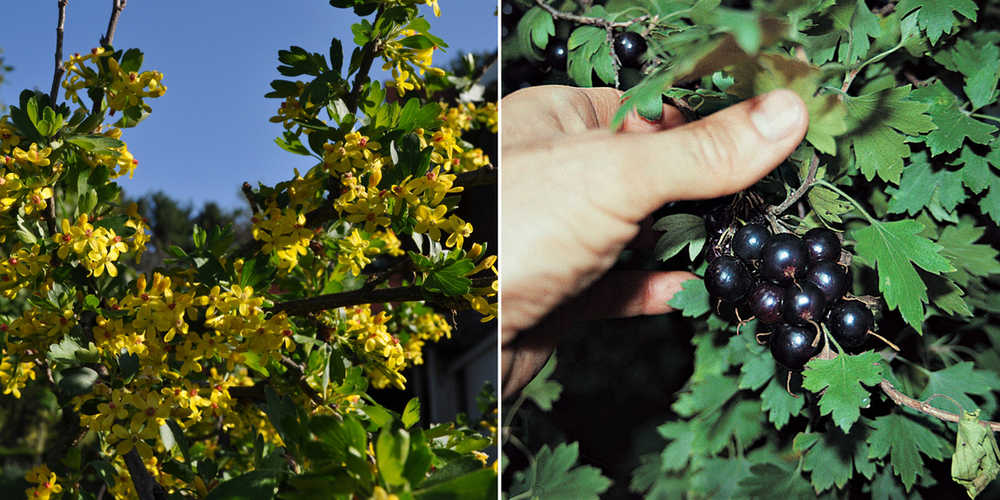More and more gardens are going native these days. Butterfly weeds are edging out delphiniums, clethra is hobnobbing with flowering dogwood, and sunflower is strutting like a prima donna.
Fruit plantings, though, are stalled in the past, with many people still planting apples, peaches or pears — all non-natives.
Yet native fruits are worth planting even if they are less familiar. Many are highly resistant to pests, which is more than can be said for apples, peaches and the like. In addition to distinctive and delectable flavors, some native fruits also are borne on handsome plants that can mingle in the landscape with other ornamentals.
Let’s foray out into the American wilderness and look at a sampling of such delectables (also covered in my book “Uncommon Fruits for Every Garden,” Timber Press, 2008).
Why not start with trees, with American persimmon (Diospyros virginiana)? This native lives up to its botanical name, meaning “food of the gods,” only if you choose one known to bear tasty fruits and can ripen them within your growing season. The best are something like a dried apricot that’s been soaked in water, dipped in honey and then given a dash of spice.
In the northernmost growing regions (into USDA Zone 4) or in coastal areas where summers stay cool, good choices are Szukis, Mohler, Yates and Dooley. In hot-summer areas and further south, choose from a slew of good varieties, including Early Golden, John Rick and Garretson. None of these varieties need another tree for cross-pollination, and all are draped throughout summer in languorous, slightly bluish leaves that, in autumn, turn a rich, golden yellow. With some varieties, the orange fruits cling to branches long after leaves drop, decorating the bare limbs like Christmas ornaments.
Mulberry (Morus rubra) is a native that perhaps would be more loved if it were more difficult to grow. (We also have non-native mulberries, and their hybrids with our natives — all delicious.)
This familiar fruit resembles a blackberry in shape, but ranges in color from deep black to red to lavender to pure white. Fruits on wild trees usually are cloying, appealing mostly to children. Illinois Everbearing and Oscar are among the best varieties — to adults — for their refreshing dash of tartness.
Mulberry leafs out late and fall color is inconsequential, so it is in summer that the tree comes into its own as an ornamental. Some weeping forms also bear fruit.
Pawpaw (Asimina triloba) is a native tree with tropical aspirations. With large, drooping, lush leaves that resemble those of avocado, this is not the sort of plant you would expect to find in woodlands of the eastern U.S. It does have botanical connections with the tropics, being the northernmost member of the Custard Apple family, which includes such delicacies as the cherimoya and soursop.
Pawpaw sheds some of its tropical airs in the fall, when its leaves turn a clear yellow. The fruits, though, carry on the tropical theme. They are the size and shape of mangos and ripen in clusters like bananas. Inside, the fruit is creamy and tastes much like banana, with hints of pineapple, avocado, vanilla and mango.
Plant two different varieties for cross-pollination (and fruit from each).
Juneberry (Amerlanchier spp.), also known as serviceberry or shadblow, is a native tree more often planted as an ornamental than for its fruit. Early spring brings clouds of white or reddish blossoms; fall ignites the leaves in purples, oranges, and yellows; and the plants continue to earn their keep through winter with neat form and striped, gray bark.
The fruits look like blueberries but have a unique flavor that is sweet and juicy, with the richness of sweet cherries and a hint of almond.
If you are looking for a native, fruiting bush rather than a tree, you might again turn to juneberry. Bushy juneberries have the same qualities as the trees do, except that they are more multi-stemmed and shrubby.
And speaking of fruits that look like blueberries, let’s segue over to the real thing. Blueberries (Vaccinium corymbosum and V. asheii) would undoubtedly be planted as ornamentals if they were not so valued for their fruits. Clusters of blossoms dangle from the stems like dainty, white bells in spring, and the leaves turn a fiery red in autumn. Even in winter, blueberry’s red stems add welcome color to the landscape, especially against a snowy backdrop.
The secret to success with blueberries is a soil low in fertility, rich in humus and very acidic.
A blueberry relative also ideal as a native fruit is lingonberry (V. vitis-idaea). This half-foot-high plant sports evergreen leaves as lustrous as those of holly and as dainty as mouse ears.
In spring and again in summer, flowers dangle from lingonberry stems like rosy white urns. Lingonberry requires the same soil conditions as blueberry, and in fact grows well in a bed with lowbush blueberry (V. angustifolium).
Both spread to create an edible groundcover; they are as happy together in a garden bed as their fruits are in a jar of jam.
Perhaps the star performer among native plants offering beauty and good flavor is a relatively unknown currant, the clove currant (Ribes odoratum). At the turn of the 19th century, it was a common dooryard shrub whose large, yellow flowers would waft spicy fragrance indoors.
Clove currant is a tough plant, able to laugh off drought, heat and cold, as well as insects and diseases, deer and birds. The shiny, blue-black berries are aromatic, fairly large and have a sweet-tart flavor.

